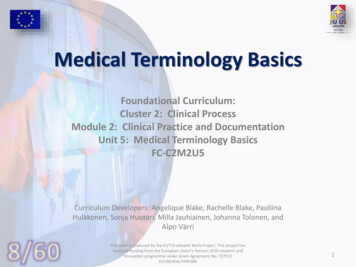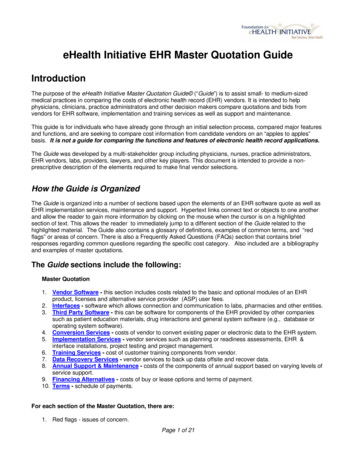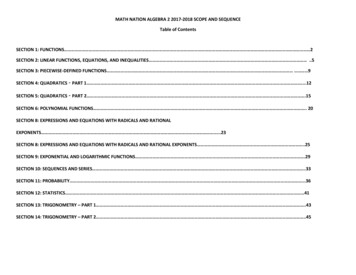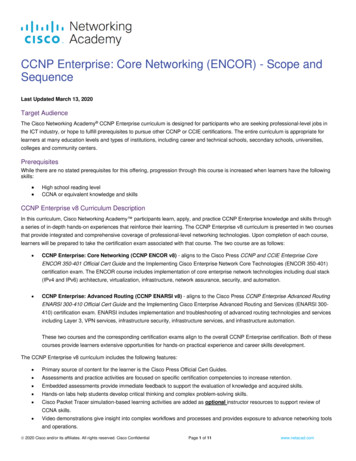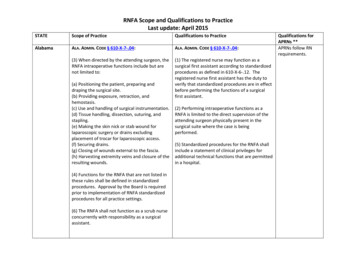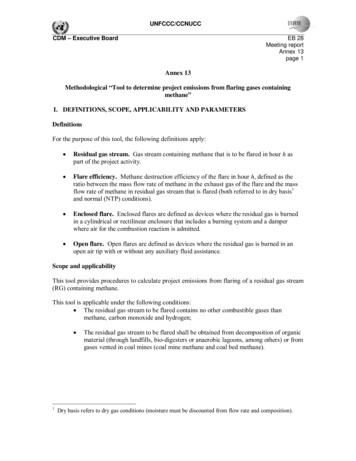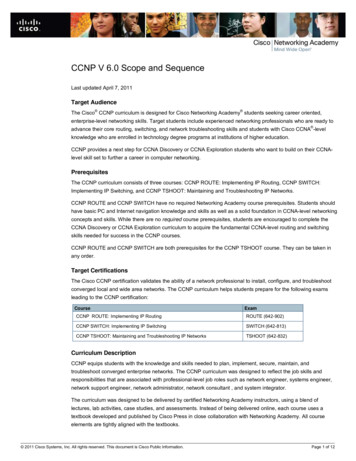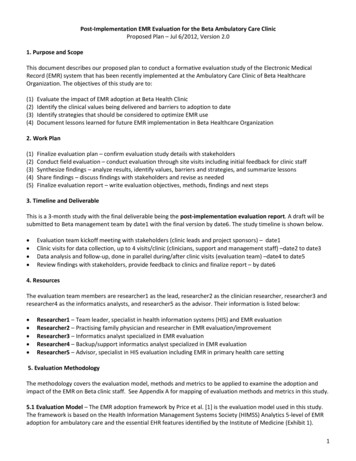
Transcription
Post-Implementation EMR Evaluation for the Beta Ambulatory Care ClinicProposed Plan – Jul 6/2012, Version 2.01. Purpose and ScopeThis document describes our proposed plan to conduct a formative evaluation study of the Electronic MedicalRecord (EMR) system that has been recently implemented at the Ambulatory Care Clinic of Beta HealthcareOrganization. The objectives of this study are to:(1)(2)(3)(4)Evaluate the impact of EMR adoption at Beta Health ClinicIdentify the clinical values being delivered and barriers to adoption to dateIdentify strategies that should be considered to optimize EMR useDocument lessons learned for future EMR implementation in Beta Healthcare Organization2. Work Plan(1)(2)(3)(4)(5)Finalize evaluation plan – confirm evaluation study details with stakeholdersConduct field evaluation – conduct evaluation through site visits including initial feedback for clinic staffSynthesize findings – analyze results, identify values, barriers and strategies, and summarize lessonsShare findings – discuss findings with stakeholders and revise as neededFinalize evaluation report – write evaluation objectives, methods, findings and next steps3. Timeline and DeliverableThis is a 3-month study with the final deliverable being the post-implementation evaluation report. A draft will besubmitted to Beta management team by date1 with the final version by date6. The study timeline is shown below. Evaluation team kickoff meeting with stakeholders (clinic leads and project sponsors) – date1Clinic visits for data collection, up to 4 visits/clinic (clinicians, support and management staff) –date2 to date3Data analysis and follow-up, done in parallel during/after clinic visits (evaluation team) –date4 to date5Review findings with stakeholders, provide feedback to clinics and finalize report – by date64. ResourcesThe evaluation team members are researcher1 as the lead, researcher2 as the clinician researcher, researcher3 andresearcher4 as the informatics analysts, and researcher5 as the advisor. Their information is listed below: Researcher1 – Team leader, specialist in health information systems (HIS) and EMR evaluationResearcher2 – Practising family physician and researcher in EMR evaluation/improvementResearcher3 – Informatics analyst specialized in EMR evaluationResearcher4 – Backup/support informatics analyst specialized in EMR evaluationResearcher5 – Advisor, specialist in HIS evaluation including EMR in primary health care setting5. Evaluation MethodologyThe methodology covers the evaluation model, methods and metrics to be applied to examine the adoption andimpact of the EMR on Beta clinic staff. See Appendix A for mapping of evaluation methods and metrics in this study.5.1 Evaluation Model – The EMR adoption framework by Price et al. [1] is the evaluation model used in this study.The framework is based on the Health Information Management Systems Society (HIMSS) Analytics 5-level of EMRadoption for ambulatory care and the essential EHR features identified by the Institute of Medicine (Exhibit 1).1
Practice ReportingAdministrative ProcessesPatient SupportElectronic CommunicationDecision SupportReferralsDiagnostics ManagementLaboratory ManagementMedication ManagementHealth InformationFunctional CategoriesOverall EMR UseEMRCapabilitySupporting eHealth InfrastructureStageDescription5Full EMR that is interconnected with regional / community hospitals, other practices,labs, pharmacists for collaborative care. Proactive and automated outreach topatients (e.g. Chronic disease management). EMR supports clinical research.4Advanced clinical decision support in use, including practice level reporting.Structured messaging between providers occurring within the office / clinic.3Computer has replaced paper chart. Laboratory data imported in structured form.Some level of basic decision support, but the EMR primarily used as an electronicpaper record.2Partial use of computers at point of care for recording patient information. Mayleverage scheduling / billing system to document reasons for visit and be able topull up simple reports.1Electronic reference material, but still paper charting. If transcription used, notesmay be saved in free text / word processing files.0Traditional paper-based practice. Charts on paper, results received on paper. Mayhave localized computerized billing and / or scheduling, but this is not used forclinical purposes.Exhibit 1 – EMR adoption framework by Price et al. [1]5.2 Evaluation Methods - The evaluation methods to be applied in this study are: EMR adoption assessment,usability testing, workflow analysis, data quality assessment, project risk assessment and practice reflection. Theseare methods published by the UVic eHealth Observatory (see Appendix B for a list of the tools).(a) EMR adoption assessment: The 5-level EMR adoption assessment model will be used to determine the level ofEMR adoption and usage associated with a given practice post EMR implementation.(b) Usability testing: A set of standardized patient personas will be used as test case scenarios to determine theusefulness/ease-of-use of the EMR in documenting typical patient cases seen in primary care settings.(c) Workflow analysis: Selected practice workflows such as prescribing practice/process can be reviewed throughworkflow analysis and observations in the practice.(d) Data quality assessment: A set of patient case queries will be used to determine the quality of the patient datarecorded in the EMR either thru standard reports from or customized queries against the EMR.(e) Project risk assessment: A set of standardized questions will be used to determine the change managementstrategies used to implement the EMR and identify potential areas of project risks. Also included is a review ofall project and related documentations made available to the study team.(f) Practice reflections: Interviews and focus groups with stakeholders will be conducted to share experience,discuss findings, provide feedback and identify practice improvement opportunities post-implementation.5.3 Evaluation Metrics - The evaluation metrics that are considered in this study are based on the Clinical AdoptionFramework by Lau et al. [2] (see Exhibit 2), which is an extension of the Infoway benefits evaluation (BE) frameworkof HIS quality, use/satisfaction, and net benefits [3]. These metrics are outlined below.(a) System features and data quality: For EMR quality, the metrics may include technical performance of the EMRand quality of its patient data in terms of accuracy, consistency and completeness.(b) System usage and satisfaction: For EMR use/satisfaction, the metrics may include actual usage pattern, selfreported use of EMR interfaces/reports, and perceived usefulness and value of the EMR.(c) Effectiveness: For net benefits care quality, the effectiveness metrics may include guideline adherence rates forpreventive care, disease management and follow-up visits, depending on data availability.(d) Efficiency: For net benefits as productivity, the efficiency metrics may include time to complete clinical andadministrative tasks such as prescribing, clinical documentation and referral.(e) Meso dimensions: People, organization and implementation related factors will be examined. People includeroles, expectations and experiences. Organization includes strategy, culture, process and infrastructures.Implementation includes deployment stage, EMR-practice fit, and project process.2
(f) Macro dimensions: Healthcare standards, policy and funding/incentives will be examined. Standards coverinteroperability such as HL7 messaging. Policy covers current data exchange practices, and funding/incentivescover provider payment schemes at the clinics.The Benefits Evaluation Framework covers the microdimensions of: System quality – EMR technical performance,usability, usefulnessInformation quality –completeness, accuracy,consistency of EMR dataNet Benefits to be examined:oQuality – care effectivenessoProductivity – care efficiencyThe Meso/Macro Dimensions in the ClinicalAdoption Framework to be examined are: People – roles, expectations, experiencesOrganization – strategy, culture, process,infrastructureImplementation – stage, project, fitStandards – interoperability, e.g. HL7Policy – data exchange, privacy Funding/incentives – payment schemesExhibit 2 – Clinical adoption framework by Lau et al. [2]5.4 Study Site and ParticipantsThe study site is the Beta Ambulatory Care Clinic which is managed by the Beta Healthcare Organization. Theparticipants are clinicians and support staff at the clinic, EMR project support team, and management responsiblefor planning and operation of the clinic at Beta Healthcare Organization. Up to four half hour face-to-face interviewsessions are planned for each clinician and support staff at the clinic. For management, a one hour interview isrequested. These are followed by a one hour focus group for clinic staff to provide feedback, one feedback sessionfor the EMR project team, and one presentation session for management, including the project sponsor. The clinicvisit schedule template is shown in Appendix C.6. References[1][2][3]Lau F, Hagens S, Muttitt S. A proposed benefits evaluation framework for health information systems in Canada.Healthcare Quarterly 2007; 10(1):112-8.Lau F, Price M, Keshavjee K. From benefits evaluation to clinical adoption: Making sense of health information systemsuccess in Canada. Healthcare Quarterly 2011; 14(1):39-45.Price M, Lau F, Lai J. Measuring EMR adoption: A framework and case study. ElectronicHealthcare 2011; 10(1): e25-e30.3
Appendix A – Evaluation Methodology MappingMapping of evaluation methods and metrics to data collection techniques used in this studyFocus GroupsData ExtractionDocument ReviewUsability/WorkflowStudyObservationsEMR adoption assessment5 stage EMR adoption model assessmentUsability testingPatient persona scenarios on front-end and backend issuesWorkflow analysisAnalysis of selected clinic processes, e.g. referral, prescribingData Quality assessmentQueries on codes, free-text, templates/forms available and usedQueries on frequencies of selected patient cases/conditionsProject risk assessmentAssessment on performance, outcomes, satisfactionDeployment process thru change/risk management assessmentPractice reflectionsUser assessment on performance, outcomes, satisfactionGroup reflections for info sharing, feedback and improvementsInterviewsBy Evaluation Methods By Evaluation MetricsSystem features and data qualityCode and data consistency, accuracy and completenessCompleteness/consistency of specific templates and flow sheetsSystem usage and satisfactionActual EMR usagePerceived EMR usefulness, ease of use and valueEffectivenessAdherence to CDM guidelines e.g., preventive care and follow-upEfficiencyImpact on clinician/support staff productivityMeso dimensionsPeople, organization and implementation factorsMacro dimensionsStandards, policy and funding/incentive factors 4
Appendix B – List of Evaluation ToolsThe evaluation tools to be used in the study are listed below. They are available on the UVic eHealth Observatorywebsite, URL – http://eHealth.uvic/ca under resources EMR adoption assessment tool – A list of interview questions used to determine the level of EMR adoption andusage at the clinic. Usability testing: A set of standardized patient personas used as test case scenarios to determine theusefulness/ease-of-use of the EMR itself. Workflow analysis: A set of routine tasks to be observed along with usability inspection to determine theworkflow patterns at the clinic. Data quality assessment: A set of patient case queries used to determine the quality of the patient datarecorded in the EMR. Project risk assessment: A set of 23 interview questions used to determine the change management strategiesused to implement the EMR and identify potential areas of project risks. Practice reflections, user assessment: A set of 9 interview questions used with project staff and management toshare experience and lessons learned about the EMR implementation project. Practice reflections, focus group: A set of 9 interview questions used with project staff and management toshare experience and lessons learned about the EMR implementation project.5
Appendix C - Clinic Visit Schedule TemplateThis section contains information on the clinic visits. It covers the participants and the visit schedule for the BetaAmbulatory Care Clinic staff. Note that the visit schedule is still being confirmed and updated at this time1. Participants - Please put in actual name and role; add more rows as neededBeta ClinicNameRole2. Type of assessments by evaluation team(a) Interviews – conduct face-to-face interviews and focus groups from half to one hour with clinicians, clinic staff,project support staff and management(b) Data quality assessment – request aggregate outputs from EMR support team based on specific database queryalgorithms and parameters(c) Usability/workflow assessment – observe clinic staff complete specific tasks using their EMR and workflowthrough different scenarios provided(d) Vendor interview – conduct phone interview on EMR features, issues and directions(e) Document review – review documents provided by EMR support team3. Interview Schedule – Up to 4 half-hour interviews per clinic staff as time permits; with a 1-hr focus group at 6:0016:30Notes: Interview1 EMR adoption assessment; Interview2 Practice reflections user assessment; Interview3 usability/workflow;Interview4 usability/workflow; Focus group practice reflections feedback6
Post-Implementation EMR Evaluation for the Beta Ambulatory Care Clinic Proposed Plan – Jul 6/2012, Version 2.0 1. Purpose and Scope This document describes our proposed plan to conduct a formative evaluation study of the Electronic Medical Record (EMR) system that has been recently implemented at the Ambulatory Care Clinic of Beta Healthcare

